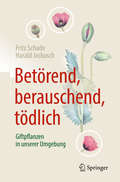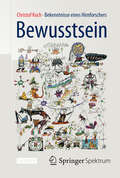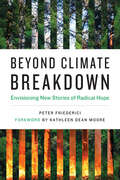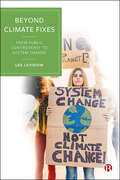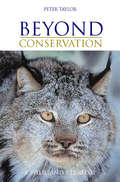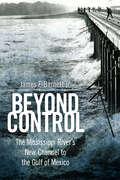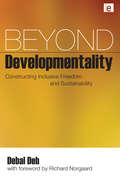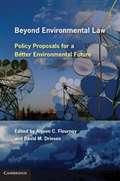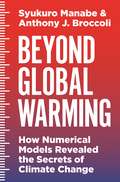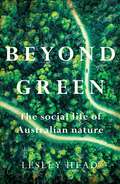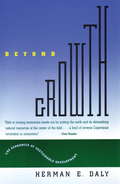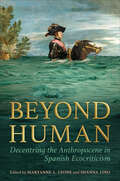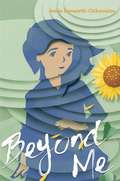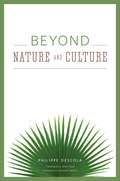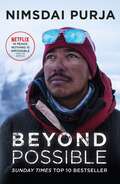- Table View
- List View
Between the Rocks and the Stars: Narratives in Natural History
by Stephen DaubertThese stories take readers where they cannot go, be it out into space, back in time, deep under the ocean, down to micro-scopic scales, or out onto the geologic overview. Squid turn themselves inside-out when disturbed by predators hunting through the darkness with sonar. Beneficial microbes spend their summer living in nectar and being transferred between blooms by the bees, then spend the winter living within those bees. Ecological stories are seen through the eyes of squirrels, birds, fish, ants, butterflies, and beetles.Between the Rocks and the Stars dives deep into the relationships that shape the natural world. The book presents a collection of vignettes from the wild, each of which describes the natural advantage of a particular organism. These true-to-life accounts are then posed in particular circumstances that illustrate the principles—commensalism, speciation—that shape the place of these organisms in their living environment. Some stories cover topics in geology and cosmology, describing the physical world context in which natural history progresses across the eons. Underlying themes in the book include the network of connections that link all these organisms together and the adaptations they make to the physical world in which they must find themselves a home.
Between the Rocks and the Stars: Narratives in Natural History
by Stephen DaubertThese stories take readers where they cannot go, be it out into space, back in time, deep under the ocean, down to microscopic scales, or out onto the geologic overview. Squid turn themselves inside-out when disturbed by predators hunting through the darkness with sonar. Beneficial microbes spend their summer living in nectar and being transferred between blooms by the bees, then spend the winter living within those bees. Ecological stories are seen through the eyes of squirrels, birds, fish, ants, butterflies, and beetles.Between the Rocks and the Stars dives deep into the relationships that shape the natural world. The book presents a collection of vignettes from the wild, each of which describes the natural advantage of a particular organism. These true-to-life accounts are then posed in particular circumstances that illustrate the principles—commensalism, speciation—that shape the place of these organisms in their living environment. Some stories cover topics in geology and cosmology, describing the physical world context in which natural history progresses across the eons. Underlying themes in the book include the network of connections that link all these organisms together and the adaptations they make to the physical world in which they must find themselves a home.
Betörend, berauschend, tödlich - Giftpflanzen in unserer Umgebung
by Fritz Schade Harald JockuschWussten Sie dass durch Honig schon mal eine Schlacht entschieden wurde? dass sich das Reinheitsgebot für Bier ursprünglich gegen eine einheimische Rauschgiftpflanze gerichtet hat? dass der Wunderbaum Palma Christi ein Eiweiß produziert, das im deutschen Kriegswaffenkontrollgesetz aufgeführt wird? wieviele Pflanzen in Ihrem Hausgarten und in Parks giftig sind? Antworten auf viele spannende Fragen wie diese liefert das Giftpflanzenbuch von Fritz Schade und Harald Jockusch. Der Künstler Schade hat Giftpflanzen nach der Natur mit Farbstiften porträtiert, der Biologe Jockusch informiert über botanische, biochemische und toxikologische Fakten. Die Darstellungen werden durch historische Rückblicke, Anekdoten und eigene Erfahrungen aufgelockert. Im Buch folgt die Anordnung der Arten in etwa der jahreszeitlichen Abfolge des ersten Auftretens auffälliger giftiger Pflanzenteile. Wie die üblichen, mit Fotografien bebilderten Giftpflanzenratgeber dient ihr Buch der Gefahrenvermeidung, betont aber auch das Anschauungs- und Lesevergnügen.Die künstlerischen Darstellungen in diesem Buch verbinden ästhetischen Reiz mit hohem Wiedererkennungswert. Sie können leichter verinnerlicht werden als detailreiche Fotografien. Das gilt vor allem für Kinder, die durch Giftpflanzen besonders gefährdet sind. Neben der blühenden wird die fruchtende Pflanze dargestellt, wenn dies für die Vergiftungsgefahr relevant ist. In die 2. Auflage wurden 12 neue Pflanzenarten aufgenommen, von denen einige derzeit die Öffentlichkeit beschäftigen.
Betörend, berauschend, tödlich - Giftpflanzen in unserer Umgebung
by Fritz Schade Harald JockuschWussten Siedass durch Honig schon mal eine Schlacht entschieden wurde?dass sich das Reinheitsgebot für Bier ursprünglich gegen eine einheimische Rauschgiftpflanze gerichtet hat? dass der Wunderbaum Palma Christi ein Eiweiß produziert, das im deutschen Kriegswaffenkontrollgesetz aufgeführt wird?wie bezaubernd schön viele Giftpflanzen sind?Antworten auf viele spannende Fragen wie diese liefert das Giftpflanzenbuch von Fritz Schade und Harald Jockusch. Der Künstler Schade hat Giftpflanzen nach der Natur mit Farbstiften porträtiert, der Biologe Jockusch hat Fachwissen und Anekdotisches aus Gegenwart und Geschichte zu diesen Pflanzen zusammengestellt. Wie die üblichen, mit Fotografien bebilderten Giftpflanzenratgeber dient ihr Buch der Gefahrenvermeidung, betont aber auch das Anschauungs- und Lesevergnügen. Die Autoren beleuchten botanische, biochemische, historische und anekdotische Zusammenhänge für jede Pflanzenart und informieren so auf unterhaltsame Weise. Im Buch folgt die Anordnung der Arten in etwa der jahreszeitlichen Abfolge des ersten Auftretens auffälliger giftiger Pflanzenteile.Die künstlerischen Darstellungen in diesem Buch verbinden ästhetischen Reiz mit hohem Wiedererkennungswert. Sie können leichter verinnerlicht werden als detailreiche Fotografien. Das gilt vor allem für Kinder, die durch Giftpflanzen besonders gefährdet sind. Neben der blühenden wird die fruchtende Pflanze dargestellt, wenn dies für die Vergiftungsgefahr relevant ist.
Beverly Buchanan: Marsh Ruins (Afterall Books / One Work)
by Amelia GroomAn illustrated examination of Beverly Buchanan's 1981 environmental sculpture, which exists in an ongoing state of ruination.Beverly Buchanan's Marsh Ruins (1981) are large, solid mounds of cement and shell-based tabby concrete, yet their presence has always been elusive. Hiding in the tall grasses and brackish waters of the Marshes of Glynn, on the southeast coast of Georgia, the Marsh Ruins merge with their surroundings as they enact a curious and delicate tension between destruction and endurance. This volume offers an illustrated examination of Buchanan's environmental sculpture, which exists in an ongoing state of ruination.
Bewusstsein: Bekenntnisse eines Hirnforschers
by Christof Koch Jorunn Wissmann Monika Niehaus-OsterlohWie kann Aktivität im Gehirn Gefühle auslösen? Wie kann "bloßes Fleisch" - so wird der Körper in Cyberpunkromanen oft abfällig genannt -- subjektives Empfinden hervorbringen? Oder allgemeiner gesagt: Wie kann etwas Physisches etwas Nichtphysisches, subjektive Zustände erzeugen? Ob es der Zahnschmerz ist, die Freude beim Anblick der eigenen Kinder oder der Geschmack eines edlen Weins, sie alle haben denselben Ursprung in der Aktivität von Nervengewebe, im Bewusstsein. Christof Koch forscht seit Jahren über das Thema Bewusstsein. In einer Art Bestandsaufnahme zeigt er den derzeitigen Stand der Forschung auf, an dem auch maßgeblich Wissenschaftler wie Francis Crick, Ned Block, David Chalmers, Stanislas Dehaene, Giulio Tononi und Wolf Singer mitgewirkt haben. Ihm erscheint nicht als Widerspruch, mit naturwissenschaftlichen, empirischen Methoden erklären zu wollen, wie Gefühle entstehen. Wir sind uns der meisten Dinge, die in unserem Kopf vorgehen, nicht bewusst. Koch postuliert, dass Zombies ohne Bewusstsein in weiten Teilen unser Leben steuern, auch wenn wir der festen Überzeugung sind, darüber selbst zu bestimmen. Seiner Meinung nach wird es gelingen, empfindungsfähige Maschinen zu bauen - er liefert eine erste Vorlage hierfür im Buch. Er reflektiert so diverse Aspekte wie die Unterscheidung zwischen Aufmerksamkeit und Bewusstsein, das Unbewusste, die Physik und Biologie des freien Willen, Hunde, den Ring der Nibelungen, den Glauben an einen persönlichen Gott und Traurigkeit. Kochs Buch ist mehr als ein wissenschaftlicher Überblick - es ist zudem Bekenntnis, Autobiographie und futuristische Spekulation.
Beyond Cape Horn: Travels in the Antarctic
by Charles NeiderWriter and Antarctic explorer Neider tells of his third trip to the frozen continent, describing the international stations there and the goals they are working toward. Neider also tours the Antarctic landscape, observing the geography and wildlife and evoking it in detail. Devoting scrutiny to the international treaties that protect the continent politically and environmentally, Neider reveals how important those treaties are. Also included in this work are interviews with Antarctic pioneers Sir Charles Wright, Sir Vivian Fuchs, and Laurence Gould.
Beyond Climate Breakdown: Envisioning New Stories of Radical Hope (One Planet)
by Peter FriedericiThe importance of telling new climate stories—stories that center the persistence of life itself, that embrace comedy and radical hope.&“How dare you?&” asked teenage climate activist Greta Thunberg at the United Nations in 2019. How dare the world&’s leaders fiddle around the edges when the world is on fire? Why is society unable to grasp the enormity of climate change? In Beyond Climate Breakdown, Peter Friederici writes that the answer must come in the form of a story, and that our miscomprehension of the climate crisis comes about because we have been telling the wrong stories. These stories are pervasive; they come from long narrative traditions, sanctioned by capitalism, Hollywood, and social media, and they revolve around a myth: that the nation exists primarily as a setting for a certain kind of economic activity. Stories are how we make sense of the world and our place in it. The story that &“the economy&” takes priority over everything else may seem foreordained, but, Friederici explains, actually reflect choices made by specific people out of self-interest. So we need new stories—stories that center the persistence of life, rather than of capitalism, stories that embrace contradiction and complexity. We can create new stories based on comedy and radical hope. Comedy never says no; hope sprouts like a flower in cracked concrete. These attitudes require a new way of thinking—an adaptive attitude toward life that slips the narrow yoke of definition.
Beyond Climate Fixes: From Public Controversy to System Change
by Les LevidowPolitical elites have been evading the causes of climate change through deceptive fixes. Their market-type instruments such as carbon trading aim to incentivise technological innovation which will supposedly decarbonize or replace dominant high-carbon systems. In practice this techno-market framework has perpetuated climate change and social injustices, thus provoking public controversy. Using this opportunity, social movements have counterposed low-carbon, resource-light, socially just alternatives. Such transformative mobilisations can fulfil the popular slogan, ‘System Change Not Climate Change’. This book develops key critical concepts through case studies such as GM crops, biofuels, waste incineration and Green New Deal agendas.
Beyond Conservation: A Wildland Strategy
by Peter TaylorAfter decades of operating off-the-backfoot and protecting and conserving nature perceived as under threat, conservationists are becoming proactive and creative in the face of habitat loss, agricultural intensification and climate change. Beyond Conservation offers a revolutionary agenda for both managing existing wildlands in Britain and for expanding and connecting such lands. Central to this strategy is the imperative to 'rewild' or restore and repair damaged habitat and ecosystems, promote existing biodiversity and reintroduce vanished plant and animal species, while working to reconcile human needs and livelihoods and the needs of nature.
Beyond Control: The Mississippi River’s New Channel to the Gulf of Mexico (America's Third Coast Series)
by James F. Barnett Jr.Beyond Control reveals the Mississippi as a waterway of change, unnaturally confined by ever-larger levees and control structures. During the great flood of 1973, the current scoured a hole beneath the main structure near Baton Rouge and enlarged a pre-existing football-field-size crater. That night the Mississippi River nearly changed its course for a shorter and steeper path to the sea. Such a map-changing reconfiguration of the country’s largest river would bear national significance as well as disastrous consequences for New Orleans and towns like Morgan City, at the mouth of the Atchafalaya River. Since 1973, the US Army Corps of Engineers Control Complex at Old River has kept the Mississippi from jumping out of its historic channel and plunging through the Atchafalaya Basin to the Gulf of Mexico. Beyond Control traces the history of this phenomenon, beginning with a major channel shift around 3,000 years ago. By the time European colonists began to explore the Lower Mississippi Valley, a unique confluence of waterways had formed where the Red River joined the Mississippi, and the Atchafalaya River flowed out into the Atchafalaya Basin. A series of human alterations to this potentially volatile web of rivers, starting with a bend cutoff in 1831 by Captain Henry Miller Shreve, set the forces in motion for the Mississippi’s move into the Atchafalaya Basin. Told against the backdrop of the Lower Mississippi River’s impending diversion, the book’s chapters chronicle historic floods, rising flood crests, a changing strategy for flood protection, and competing interests in the management of the Old River outlet. Beyond Control is both a history and a close look at an inexorable, living process happening now in the twenty-first century.
Beyond Developmentality: Constructing Inclusive Freedom and Sustainability
by Debal DebHistory tells us that industrial development with all of its pollution, inequity and exploitation is the inevitable destiny of human societies. Yet is this really the case or are we trapped in a prevailing 'develop-mentality' that demands an endless cycle of inputs, outputs, consumption and waste on a finite planet? And is there another, better way for humans and the biosphere? This incisive, epic work turns the dominant industrial development model and its economics upside down and argues for a new way of thinking about the meaning of development and the complexion of our economy. The book traces the origin and development of the concept of development in the economic context, and suggests a way to achieving post-industrial development with zero industrial growth. The book argues that sustainable development is possible only when concerns for biodiversity and human development are put at the centre of the economy and social policy. It both provides a theoretical foundation to sustainability and presents practical instances of sustainable production systems. Coverage is magisterial and includes history, ecology, economics, anthropology, policy analysis, population theory, sociology, the Marxian critique of capitalism, Orientalism, semiotics and sociology of science. These are interwoven in an accessible but challenging way that enables readers to look at development theory, economics, consumerism and environmentalism from a new vantage point. Distinguishing features includes a critique of development from a natural science perspective, a fresh and thorough account of the concept of sustainability both from a theoretical and empirical perspective and the application of an evolutionary biology metaphor to building a socially responsible alternative to the prevailing developmentality. This is the most sweeping coverage of critical issues in economics, environment, development and sustainability available. It is both an empowering and necessary read for students, academics, professionals and activists from across sustainability, development, economics and environmental studies and beyond, and an invaluable repository of information about the critical issues facing humanity as we continue to develop our over-crowded planet.
Beyond Environmental Law
by Alyson C. Flournoy David M. DriesenThis book offers a vision for the third generation of environmental law designed to enhance its ability to protect our environment. The book presents two core proposals, an Environmental Legacy Act to preserve a defined environmental legacy for future generations and an Environmental Competition Statute to spark movement to new clean technologies. The first proposal would require, for the first time, that the federal government define an environmental legacy that it must preserve for future generations. The second would establish a market competition to maximize environmental protection. The balance of the book provides complimentary proposals and analysis. The first generation of environmental law sought broad protection of health and the environment in a fairly fragmented way. The second sought to enhance environmental law's efficiency through cost-benefit analysis and market mechanisms. These proposals seek to create a broader, more creative approach to solving environmental problems.
Beyond Fair Chase: The Ethnic & Tradition of Hunting
by Jim PosewitzBeyond Fair Chase is for anyone concerned about the future of hunting. In simple but powerful text, it describes the ethical way to hunt, from preparation to shooting to care after the shot. Never before have so many issues been linked together in an ethical context.
Beyond Global Warming: How Numerical Models Revealed the Secrets of Climate Change
by Syukuro Manabe Anthony J. BroccoliA definitive account of how we have come to understand the fundamental processes behind global warmingSyukuro Manabe is perhaps the leading pioneer of modern climate modeling. Beyond Global Warming is his compelling firsthand account of how the scientific community came to understand the human causes of climate change, and how numerical models using the world’s most powerful computers have been instrumental to these vital discoveries.Joined by atmospheric scientist Anthony Broccoli, Manabe shows how climate models have been used as virtual laboratories for examining the complex planetary interactions of atmosphere, ocean, and land. Manabe and Broccoli use these studies as the basis for a broader discussion of human-induced global warming—and what the future may hold for a warming planet. They tell the stories of early trailblazers such as Svante Arrhenius, the legendary Swedish scientist who created the first climate model of Earth more than a century ago, and they provide rare insights into Manabe’s own groundbreaking work over the past five decades. Expertly walking readers through key breakthroughs, they explain why increasing atmospheric carbon dioxide has caused temperatures to rise in the troposphere yet fall in the stratosphere, why the warming of the planet’s surface differs by hemisphere, why drought is becoming more frequent in arid regions despite the global increase in precipitation, and much more.Authoritative and illuminating, Beyond Global Warming is an invaluable insider’s look at some of today’s most cutting-edge Earth science, and a rare window into a brilliant scientific mind.
Beyond Governments: Making Collective Governance Work - Lessons from the Extractive Industries Transparency Initiative
by Eddie Rich Jonas MobergIn a world characterized by globalization, governments increasingly find themselves unable to govern. Corruption is everywhere, natural resources are being exploited, the environment damaged, markets distorted, and the fight against poverty is often ineffective. Certain challenges cannot be addressed by governments alone. Increasingly, collective governance “beyond governments” is seen as part of the solution, with state and non-state actors working together. This book sets out a framework for those wishing to implement collective governance, involving civil society, companies and governments as key actors. Based on over eight years of running the most advanced example of collective governance at international level, the Head and Deputy Head of the Extractive Industries Transparency Initiative (EITI) outline the practicalities and pitfalls, and draw out the experience of the EITI as a case example. Beyond Governments tells a positive story of how this type of innovative governance can make real achievements, but also cautions against those who see collective governance as a silver bullet to solve development challenges. It provides practical guidance from a practitioner’s perspective and is essential reading for those in government, business and academia.
Beyond Green: The Social Life of Australian Nature
by Lesley HeadHow are we to think about nature and the environment? The idea of nature as it relates to culture, society and humans has always been in constant flux and highly contested. Lesley Head interrogates the ways the cultures of nature have operated in Australia across time, and how these ways of thinking and being limit our capacity to deal with the challenges of the climate change and biodiversity crises. Drawing on her life&’s work and lessons she has picked up along the way, Head suggests that it is up to us to attentively listen, the better to destabilise and subvert dominant narratives, and to imagine new possibilities. She believes we have the nous, resources and lessons from Indigenous, settler-descendant and immigrant cultures to reduce risk in the face of the unexpected and the unimaginable. In Beyond Green, the story of nature and people weaves research and personal experience through many different times and spaces, offering new ways of understanding. It is a richly creative engagement with the abundant possibilities and pleasure of nature as a place of regeneration that is as warned by the rawk of the crow as it is accompanied by the carolling of magpies.
Beyond Growth
by Herman E. Daly"Daly is turning economics inside out by putting the earth and its diminishing natural resources at the center of the field . . . a kind of reverse Copernican revolution in economics." --Utne Reader"Considered by most to be the dean of ecological economics, Herman E. Daly elegantly topples many shibboleths in Beyond Growth. Daly challenges the conventional notion that growth is always good, and he bucks environmentalist orthodoxy, arguing that the current focus on 'sustainable development' is misguided and that the phrase itself has become meaningless."--Mother Jones"In Beyond Growth, . . . [Daly] derides the concept of 'sustainable growth' as an oxymoron. . . . Calling Mr. Daly 'an unsung hero,' Robert Goodland, the World Bank's top environmental adviser, says, 'He has been a voice crying in the wilderness.'" --G. Pascal Zachary, The Wall Street Journal"A new book by that most far-seeing and heretical of economists, Herman Daly. For 25 years now, Daly has been thinking through a new economics that accounts for the wealth of nature, the value of community and the necessity for morality." --Donella H. Meadows, Los Angeles Times"For clarity of vision and ecological wisdom Herman Daly has no peer among contemporary economists. . . . Beyond Growth is essential reading."--David W. Orr, Oberlin College"There is no more basic ethical question than the one Herman Daly is asking." --Hal Kahn, The San Jose Mercury News"Daly's critiques of economic orthodoxy . . . deliver a powerful and much-needed jolt to conventional thinking." --Karen Pennar, Business WeekNamed one of a hundred "visionaries who could change your life" by the Utne Reader,Herman Daly is the recipient of many awards, including a Grawemeyer Award, the Heineken Prize for environmental science, and the "Alternative Nobel Prize," the Right Livelihood Award. He is professor at the University of Maryland's School of Public Affairs, and coauthor with John Cobb, Jr., of For the Common Good.
Beyond Human: Decentring the Anthropocene in Spanish Ecocriticism (Toronto Iberic #83)
by Maryanne L. Leone Shanna LinoChronicling sixteenth-century Spain to the present day, Beyond Human aims to decentre the human and acknowledge the material historicity of more-than-human nature. The book explores key questions relating to ecological equity, justice, and responsibility within and beyond Spain in the Anthropocene. Examining relations between Iberian cultural practices, historical developments, and ecological processes, Maryanne L. Leone, Shanna Lino, and the contributors to this volume reveal the structures that uphold and dismantle the non-human–human dichotomy and nature-culture divide. The book critiques works from the Golden Age to the twenty-first century in a wide range of genres, including comedia, royal treatises, agricultural reports, paintings, satirical essays, horror fiction and film, young adult and speculative literature, poetry, graphic novels, and television series. The authors contend that Spanish cultural studies must expose the material historicity that entangles today’s ecological crises and ecosocial injustices with previous, future, and contemporary entities. The book argues that this will require the simultaneous decentring of the human and of the Anthropocene as an ecocritical framework. By standardizing ecosocial analysis and widening avenues for ecopedagogical approaches, Beyond Human participates in the ecocentric transformation of Hispanic cultural studies.
Beyond Jack-O'-Lanterns
by Sue GagliardiWhat kind of fruit could be a boat, a race car, and a work of art? An Atlantic Giant Pumpkin!
Beyond Me
by Annie Donwerth-ChikamatsuIn the spirit of A Place to Belong, this remarkable novel-in-verse examines the aftershocks of the earthquake and tsunami that devastated Japan in 2011 through the eyes of a young girl who learns that even the smallest kindness can make a difference.March 11, 2011 An earthquake shakes Japan to its core. A tsunami crashes into Japan&’s coast. Everything changes. In the aftermath of the natural disasters that have struck her country, eleven-year-old Maya is luckier than many. Her family didn&’t lose their home, their lives, or each other. But Maya still can&’t help feeling paralyzed with terror, and each aftershock that ripples out in the days that follow makes her fear all over again that her luck could change in an instant. As word of the devastation elsewhere grows increasingly grim—tens of thousands have perished—it all seems so huge, so irreparable. Already flinching at every rumble from the earth, Maya&’s overcome with a sense of helplessness and hopelessness. How can her country ever recover, and how could anything she does possibly make a difference? Before Maya can extend a hand to others, she must dig deep to find the hidden well of strength in herself in this sweeping, searing novel that shows even small acts can add something greater and help people and communities heal.
Beyond Nature and Culture
by Philippe DescolaPhilippe Descola has become one of the most important anthropologists working today, and Beyond Nature and Culture has been a major influence in European intellectual life since its French publication in 2005. Here, finally, it is brought to English-language readers. At its heart is a question central to both anthropology and philosophy: what is the relationship between nature and culture? Culture--as a collective human making, of art, language, and so forth--is often seen as essentially different from nature, which is portrayed as a collective of the nonhuman world, of plants, animals, geology, and natural forces. Descola shows this essential difference to be, however, not only a specifically Western notion, but also a very recent one. Drawing on ethnographic examples from around the world and theoretical understandings from cognitive science, structural analysis, and phenomenology, he formulates a sophisticated new framework, the "four ontologies"-- animism, totemism, naturalism, and analogism--to account for all the ways we relate ourselves to nature. By thinking beyond nature and culture as a simple dichotomy, Descola offers nothing short of a fundamental reformulation by which anthropologists and philosophers can see the world afresh.
Beyond Possible: '14 Peaks: Nothing is Impossible' Now On Netflix
by Nimsdai PurjaAn SBS Gurkha soldier's account of how his tough Nepali upbringing and the lessons learned in his army life enabled his record-breaking conquest of all 14 of the world's 8,000m peaks in under 7 months.What happens when ambition meets limitless imagination? Enter Project Possible: a seemingly unreachable goal to climb all fourteen "death zone" mountains in record time. The previous record was seven years, ten months and six days. I did it in six months.This is the inside story of my incredible adventure. As a kid in Nepal, barefoot in the mountains, I developed the resilience I needed to later join the Gurkhas, one of the most fearless forces in the British Army. Then in the Special Boat Service I served in some of the world's most dangerous warzones.But my next challenge was even more of a test.In Beyond Possible I'll reveal how I conquered the world's most dangerous peaks, breaking several world records in the process. With my elite training, I was able to adapt quickly to the lethal conditions, rarely phased by the lung-burning temperatures or brutal winds. Fear became irrelevant because I had belief. In the death zone, I came alive. But even after facing countless challenges, right at the peak of my achievements, my world fell apart when my mother was hospitalized.But I survived and ultimately conquered the most deadly and hostile mountains on the planet. Beyond Possible is my story.(P)2020 Hodder & Stoughton Limited
Beyond Possible: The man and the mindset that summitted K2 in winter
by Nimsdai Purja'An inspirational study in leadership and a powerful testament to the human spirit at its very best.'- Mail on Sunday'If you're going to get one book this year get Beyond Possible.' - Ant Middleton'The energy of the book gives it pace and you whip through, rather as Purja nips up verticals... Whether or not you are a lover of the mountains, you will marvel at his tenacity, his fearlessness. No one can fail to be inspired by what he achieved.' - The Times'Not only does Nims have exceptional physical stamina, he's also a leader with great skills in financial management and logistics.' - Reinhold Messner, the first person to climb all fourteen highest mountains in the world'The magnitude of his achievement is astonishing.' Soldier Magazine'A Living Legend.' Trail Magazine***In Beyond Possible Nimdai Purja tells the story of his life before his recent epic achievement of leading the team that scaled K2 in winter. He reveals how leadership, a willingness to learn, integrity and collaboration are essential qualities behind the world's greatest mountaineering feats. Nimsdai is the first man ever to summit all 8000m 'Death Zone' peaks in less than 7 months, and this book reveals the man behind the climbs - how his early life in Nepal and Special Forces training made him the person to go beyond possible...
Beyond Possible: The man and the mindset that summitted K2 in winter
by Nimsdai Purja'An inspirational study in leadership and a powerful testament to the human spirit at its very best.' - Mail on Sunday'If you're going to get one book this year get Beyond Possible.' - Ant Middleton'The energy of the book gives it pace and you whip through, rather as Purja nips up verticals... Whether or not you are a lover of the mountains, you will marvel at his tenacity, his fearlessness. No one can fail to be inspired by what he achieved.' - The Times'Not only does Nims have exceptional physical stamina, he's also a leader with great skills in financial management and logistics.' - Reinhold Messner, the first person to climb all fourteen highest mountains in the world'The magnitude of his achievement is astonishing.' Soldier Magazine'A Living Legend.' Trail Magazine***In Beyond Possible Nimdai Purja tells the story of his life before his recent epic achievement of leading the team that scaled K2 in winter. He reveals how leadership, a willingness to learn, integrity and collaboration are essential qualities behind the world's greatest mountaineering feats. Nimsdai is the first man ever to summit all 8000m 'Death Zone' peaks in less than 7 months, and this book reveals the man behind the climbs - how his early life in Nepal and Special Forces training made him the person to go beyond possible...

